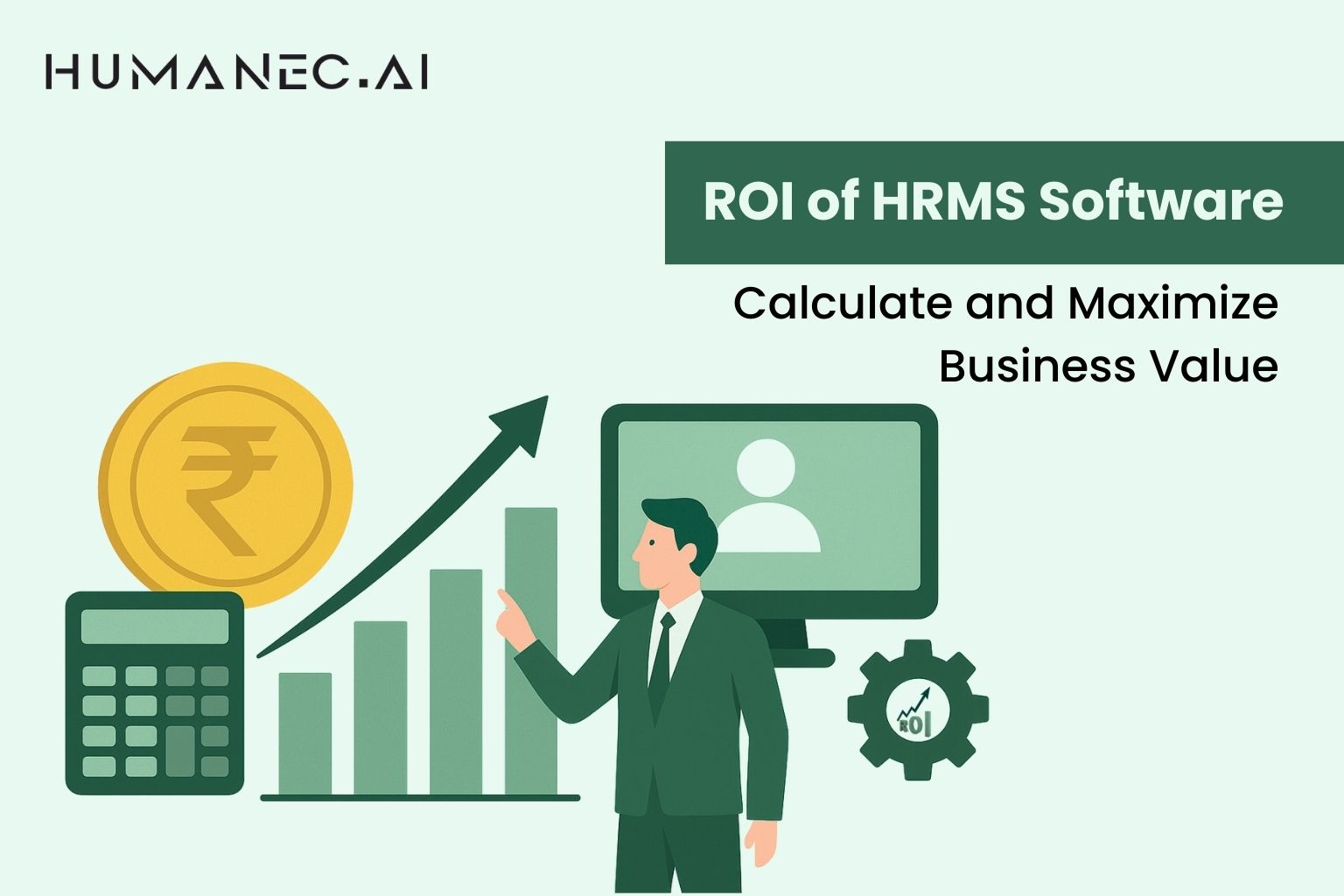
ROI of HRMS Software: How to Calculate It & Maximize Business Value
Human Resource Management Software (HRMS) is no longer just a digital tool for automating HR tasks—it has become a strategic investment that directly impacts business growth, cost efficiency, and workforce productivity. For small businesses, HR professionals, and business owners, understanding the ROI of HRMS software is essential to ensure that every rupee invested delivers measurable returns.
In this blog, we’ll cover what ROI in HR software means, how to calculate it effectively, and proven strategies to maximize the business value of HR automation.
What is ROI in HRMS Software?
ROI (Return on Investment) in HRMS software measures the financial and operational value gained compared to the cost of implementing the system. It helps businesses evaluate whether HR automation is worth the investment and whether it is driving tangible results in cost savings, efficiency, compliance, and employee satisfaction.
In simple terms, ROI tells you:
“For every ₹1 invested in HRMS, how much value is your business getting back?”
Why ROI of HR Software Matters
HR software is a long-term strategic decision, not just a technology upgrade. When implemented correctly, HRMS delivers measurable impact across several areas:
- Reduces manual HR work & errors by automating repetitive tasks
- Cuts costs in payroll, compliance, and workforce management
- Improves employee experience & engagement through self-service portals
- Enables data-driven decisions via analytics and reporting
- Frees HR teams to focus on strategy instead of admin work
By tracking ROI, businesses ensure they are not just adopting software but achieving measurable outcomes.
How to Calculate the ROI of HRMS Software
The basic ROI formula is:
ROI (%) = (Net Benefits ÷ Cost of Investment) × 100
Here’s how to apply it for HRMS:
1. Identify Costs:
- Software licensing & subscription
- Implementation & setup
- Training & adoption
- Ongoing support & maintenance
2. Measure Benefits:
- Cost savings from automation
- Fewer compliance penalties
- Reduced hiring costs
- Improved HR productivity
- Better workforce utilization
3.Calculate Net Benefits: Total Benefits – Total Costs
4. Apply ROI Formula:
Convert the result into a percentage for clear financial insights.
Example: If your HRMS costs ₹5,00,000 annually but saves ₹12,00,000 in reduced errors, saved HR time, and compliance improvements:
ROI = (₹12,00,000 – ₹5,00,000) ÷ ₹5,00,000 × 100 = 140%
That means for every ₹1 spent, your business gets ₹2.40 back — a strong ROI.
Understanding ROI in HRMS Software
When businesses invest in HRMS or any software solution, the most important factor they look at is the return on investment (ROI). A strong ROI indicates that the system is not just an expense but a tool that actively contributes to cost savings, efficiency, and overall business growth.
For HRMS, a good ROI generally falls between 150% – 300% within the first 1–2 years of implementation. This comes from measurable benefits such as:
- Time saved by automating manual HR tasks
- Reduction in payroll errors and associated costs
- Improved compliance with labor laws and tax regulations
- Enhanced employee productivity and engagement
These factors collectively demonstrate why HR software quickly pays for itself and continues to deliver long-term value.
ROI in HR Programs and Initiatives
Beyond HRMS, ROI is also applicable to other HR initiatives like employee training, onboarding programs, and workforce development. In this context, ROI reflects the balance between the cost of running these programs and the value they deliver, whether through better performance, reduced turnover, or faster employee ramp-up time.
How to Calculate ROI for HRIS/HRMS
The formula to calculate ROI is straightforward:
ROI=(NetBenefits–CostofHRMS)CostofHRMS×100ROI = frac{(Net Benefits – Cost of HRMS)}{Cost of HRMS} times 100ROI=CostofHRMS(NetBenefits–CostofHRMS)x100
For example, let’s assume your company implements Humanec HRMS, which saves around ₹10,00,000 annually in HR costs while costing ₹3,00,000. The ROI calculation would be:
ROI=(10,00,000–3,00,000)3,00,000×100=233%ROI = frac{(10,00,000 – 3,00,000)}{3,00,000}times 100 = 233ROI=3,00,000(10,00,000–3,00,000)x100=233%
Example of ROI of HRMS Software
A mid-sized business with 300 employees spends ₹15 lakh annually on manual HR processes. After implementing Humanec HRMS, costs drop to ₹7 lakh while payroll efficiency improves by 40%. Net savings = ₹8 lakh. With an annual software cost of ₹3 lakh, ROI = 166% in the first year itself.
Key Areas Where HRMS Delivers ROI
- Payroll & Compliance Automation – Reduces costly errors, late fees, and penalties.
- Time & Attendance Tracking – Eliminates productivity loss and improves workforce discipline.
- Recruitment & Onboarding – Shortens hiring cycles and lowers recruitment costs.
- Employee Self-Service Portals – Minimizes repetitive HR queries.
- Data & Analytics – Provides real-time workforce insights for smarter decision-making.
- Performance & Engagement Tools – Improves retention and reduces turnover costs.
How to Maximize ROI from HRMS
Investing in HRMS is only the first step. To maximize ROI:
- Select the right HRMS tailored to your company’s size, industry, and needs.
- Train and onboard employees effectively to ensure full adoption.
- Integrate HRMS with payroll, attendance, and other business systems for seamless operations.
- Track ROI metrics regularly and optimize workflows.
- Leverage AI-driven automation to reduce manual effort and improve accuracy.
- Choose cloud-based HRMS for scalability, flexibility, and lower infrastructure costs.
With a platform like Humanec HRMS, businesses can maximize ROI by combining automation, compliance, and analytics into one unified system.
Conclusion: Maximizing the ROI of HRMS Software
The ROI of HRMS software is not just about financial returns—it’s about creating a more efficient, compliant, and people-focused organization. By calculating ROI correctly and implementing strategies to maximize value, businesses can:
- Reduce HR costs
- Improve workforce efficiency
- Enhance employee satisfaction
- Gain a long-term competitive advantage
If your goal is to maximize the ROI of HRMS software, Humanec provides a modern, AI-powered HRMS that enables automation, compliance, and business growth.
Discover how Humanec can transform your HR:
Book a Demo:
Visit WebsiteDownload the Humanec App:
- Android :Download Now
- iOS :Download Now
View Pricing Price:
FAQs
What is a good ROI for HRMS software?
A good ROI ranges from 150% to 300% within 1–2 years, depending on company size, automation level, and cost savings achieved.
How do you calculate ROI in HR programs?
ROI in HR programs is calculated by comparing the benefits (savings, productivity, retention) against the costs of implementing HR initiatives or software.
What is the average cost of HRMS software in India?
On average, HRMS software in India costs ₹100–₹400 per employee/month for SaaS solutions like Humanec. Enterprise-grade solutions may cost more.
What is ROI in HR programs?
It is the financial return on HR investments, such as automation, training, or employee engagement programs, measured against the cost incurred.
How to calculate ROI for HRIS software?
Use the formula: ROI = (Net Benefit – Total Cost) / Total Cost × 100 Example: If HRMS saves ₹10,00,000 annually and costs ₹3,00,000, ROI = 233%.
Can you give an example of ROI from HRMS software?
Yes. A 300-employee company reduced HR costs by ₹8 lakh annually with Humanec HRMS while paying ₹3 lakh in software fees, achieving a 166% ROI in one year.






